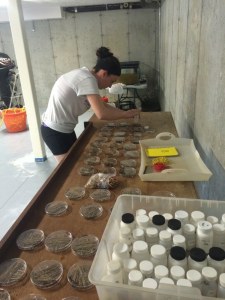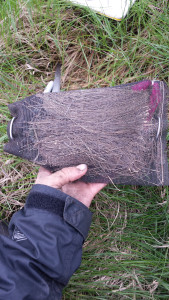


Melampus bidentatus, commonly known as the Coffee Bean snail, is a terrestrial air-breathing snail in the family Ellobiidae. This species is relatively small, averaging 9 to 12 mm when fully grown. As a detritivore located on the high marsh, Melampus commonly feeds on Spartina patens and the algae that grows on the stems of these plants. The majority of my project is researching the effects of Melampus density on Spartina patens litter processing. While exploring density effect, I am also pursuing the question on whether or not there is a fertilizer effect. In both of my experiments we are using dead Spartina patens from Sweeney and West creeks and Melampus. Sweeney creek serves as our enriched creek and West creek is used as our reference. By using these two different creeks, we can compare the effect of Melampus on mass loss.
To better understand whether or not Melampus increases the decomposition rate of Spartina litter that has been nutrient-enriched, two experiments were set up. One experiment takes into consideration natural environmental factors and Melampus in its natural habitat. In this experiment, I used decomposition bags made of window screen and placed a known amount of dead Spartina patens and different densities of snails in each bag. These bags were then deployed out in the field at both creeks each containing litter from that creek. For the second experiment, I set up petri dishes. Half of these dishes contained litter from Sweeney creek and the other half West. Each dish had a known mass of detritus and a random density, or number, of Melampus individuals.
At the end of the field season, roughly 8 weeks from now, I will be measuring the mass loss, nitrogen content, phenolic content, particle size, and snail growth for both experiments. All together I hope to gain a better understanding of the importance of this snail on decomposition and determine if nitrogen enrichment and density play a role in the process of decomposition.
Elise Baron
So awesome, all grown up! This is well written, although some of the terms you referenced I don’t know, I got a great sense of what you are doing over this summer. Mwah thumbs way up girl.
Elise Baron
<3